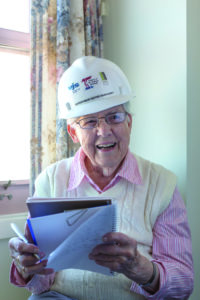COLLEEN JURKIEWICZ
CATHOLIC HERALD STAFF

As Franciscan women, the Sisters of St. Francis of Assisi (OSF) embrace a life of simplicity. Since their founding in 1849 on the shores of Lake Michigan, their charism ministering to those in material, physical or spiritual need manifests itself in the joyful austerity of their day-to-day life — doing without, offering it up, carrying their crosses and never complaining.
But several years ago, when the sisters began to assess the quality and efficiency of their buildings on South Lake Drive in St. Francis, it became clear that there was such a thing as too much austerity.
Take Sr. Margaret Gardner. The 98-year-old native of Maine joined the Franciscan Sisters of Baltimore in 1941 and moved to Milwaukee about two years ago, after that community merged with the OSF in 2001. She spent decades in education, serving as a house parent for disadvantaged boys and a school principal in Harlem and Virginia; she has also done pastoral work and was the administrator of the order’s motherhouse for a time. She continues to be a voracious reader and a nimble seamstress who sews handcrafted bags to support the sisters’ Franciscan Center in Baltimore.
Before moving into her residence at the new convent in the third week of May, Sr. Margaret resided on the fourth floor of the old Sisters of St. Francis of Assisi Motherhouse just off South Lake Drive, situated behind the site of the now-demolished Marian Center for Nonprofits, where the OSF educated more 8,000 young women when it was St. Mary’s Academy from 1904-91.
Until recently, about 40 sisters like Sr. Margaret lived on its upper floors, which date to the 19th century. The hallways were narrow, and the sisters shared a communal bathroom located at the end of the hall, though all utilize a walker or wheelchair. There was a cramped meeting room where recreational therapy could take place. Chapel and meal services were on different floors, and only one elevator could accommodate multiple wheelchairs; the other could only hold one wheelchair and one walker, making choreography for large-scale moves an excruciating daily ballet for both staff and residents.
And in the event of an emergency, the sisters would have had to be rescued from a shallow balcony off the fourth floor, accessible by a doorway that most people would have to duck to fit underneath.
More than seven years ago, the OSF began working with consultants like Groth Design Group to study the options available to them. It was announced in 2017 that the Marian Center would be demolished to make way for a new motherhouse. Ground broke on that building in October of that year, and in early May, Sr. Margaret and the other new residents were able to get their first glimpses of their new 137,000-square-foot, state-of-the-art home.
Ever the Franciscan, Sr. Margaret shrugs off the idea that life in the old motherhouse was a hardship. “This building has grown on me; I’m going to be sad to leave,” she said. “I like to think about the sisters that have gone before, that have used this place and used it so well, and their ministries.”
But a side-by-side comparison of the two buildings shows the very clear improvement of quality of life for the sisters and their caregivers. The facility is actually three buildings in one — Clare Circle, which will serve the needs of patients with dementia, Elizabeth Hall, where assisted living quarters are located, and Town Square in between, where an expansive atrium filled with light welcomes the public to the OSF’s new administrative offices.
The new building incorporates about 50 items salvaged from St. Mary’s Academy/Marian Center and the old Motherhouse, including a bronze relief of St. Francis that adorns the new convent facade facing Lake Drive, two large ornate doors that are original to the Mother General’s office, the 1904 and 1930 cornerstones and two copper cupolas.
Sr. Margaret kept a careful eye on the building process; perched on the windowsill of her room, she could see the daily goings-on at the construction site and took notes on its progress. The VJS Construction workers nicknamed her “Sister Supervisor” and gave her her own hardhat.
“I was just so fascinated by everything they have been doing. Words can’t describe — I’ve spent hours, hours there, just watching them, just admiring them, the way they work, the way things come together,” she said.
The building was designed with the future in mind, built to a standard higher than code required, explained Steve Petit of Groth Design Group. Some units in Elizabeth Hall were built to be converted into two-room apartments that could, in the future, accommodate lay residents who may occupy the facility after the sisters no longer have need of it. The same goes for the Town Square, where offices and meeting areas can easily be converted into common space, a movie theater, gym or salon/spa area.
All of the resident rooms in Elizabeth Hall are located on the exterior of the building, with windows situated low to the ground so the view can be enjoyed by someone in a wheelchair. Each unit has its own heating and cooling system, fully accessible bathroom, microwave, television and Amish-made wardrobe.
Of all the amenities, however, Sr. Margaret, is most impressed with the large covered porch constructed off of Elizabeth Hall, surrounded by retractable screens. From there, she will be able to see the St. Francis Chapel of the original motherhouse.
“When I can’t sleep at night,” she said, “I’ll go out and sit on the porch and watch for deer.”
